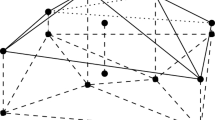Abstract
We prove the validity of one- and two-term Edgeworth expansions under optimal conditions (a Cramer-type smoothness condition and the minimal moment conditions) and provide precise bounds for the remainders of expansions. The bounds depend explicitly on the ratiop=N/n, whereN andn denote the sample size and the population size, respectively.
Similar content being viewed by others
References
W. Albers, P. J. Bickel, and van W. R. Zwet, Asymptotic expansions for the power of distribution free tests in the one-sample problem,Ann. Statist.,4, 108–156 (1976).
G. J. Babu and Z. D. Bai, Mixtures of global and local Edgeworth expansions and their applications,J. Multivariate Anal.,59, 282–307 (1996).
A. Bikelis, On the estimation of the remainder term in the central limit theorem for samples from finite populations,Studia Sci. Math. Hungar.,4, 345–354 (1974).
M. Bloznelis, A Berry-Esseen bound for finite population Student's statistic, Preprint 97-17, Faculty of Mathematics, Vilnius University.
M. Bloznelis and F. Götze, An Edgeworth expansion for finite populationU-statistics, to appear inBernoulli (1997).
P. Erdös and A. Rényi, On the central limit theorem for samples from a finite population,Publ. Math. Inst. Hungar. Acad. Sci.,4, 49–61 (1959).
W. Feller,An Introduction to Probability Theory and Its Applications, Vol. II, Wiley, New York (1971).
W. Hoeffding, Probability inequalities for sums of bounded random variables,J. Amer. Statist. Assoc.,58, 13–30 (1963).
T. Höglund, Sampling from a finite population. A remainder term estimate,Scand. J. Statist.,5, 69–71 (1978).
P. N. Kokic and N. C. Weber, An Edgeworth expansion forU-statistics based on samples from finite populations,Ann. Probab.,18, 390–404 (1990).
V. V. Petrov,Limit Theorems in Probability Theory. Sequences of Independent Random Variables, Oxford Univ. Press, New York (1995).
C. R. Rao and L. C. Zhao, Berry-Esseen bounds for finite-populationt-statistics,Statist. Probab. Lett.,21, 409–416 (1994).
J. Robinson, An asymptotic expansion for samples from a finite population,Ann. Statist.,6, 1005–10011 (1978).
Zhao Lin Cheng and Chen Xi Ru, Normal approximation for finite-populationU-statistics,Acta Math. Appl. Sinica,6, 263–272 (1990).
Author information
Authors and Affiliations
Additional information
Supported by the Alexander von Humboldt Foundation.
Published in Lietuvos Matematikos Rinkinys, Vol. 40, No. 3, pp. 277–294, July–September, 2000.
Rights and permissions
About this article
Cite this article
Bloznelis, M. One- and two-term edgeworth expansions for a finite population sample mean. Exact results. I. Lith Math J 40, 213–227 (2000). https://doi.org/10.1007/BF02465130
Received:
Issue Date:
DOI: https://doi.org/10.1007/BF02465130




